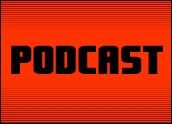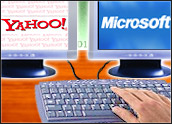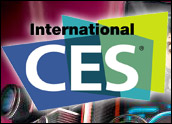
So how’s your head after that wild Windows 7 launch party with the Stepford crew? Still got the spins? OK, if you really did throw or attend an official Windows 7 launch party, then that’s … interesting. I sincerely hope you had a good time. For the rest of us, the official introduction of Windows 7 was a pretty austere affair. No human billboards this time around, no Santana, no fireworks, and no around-the-block lines at Best Buy, as far as I could tell.
But the size of the party a company throws for itself is no way to measure the success of a new operating system.
Instead, let’s try comparing it to completely unrelated goods, like books. By that standard, it’s a win: Pre-orders for Windows 7 at Amazon UK topped those of J.K. Rowling’s Harry Potter and the Deathly Hallows, whatever that means.
How about your competitors — are they paying attention? Do they have enough respect for your product that they do a little something to try and steal your thunder, or do they ignore you completely? Well, Apple worked hard to get Snow Leopard to market before Windows 7, then it pushed out some new products earlier this week. And Canonical partnered with IBM to market what they say is desktop alternative to Windows 7. So again, a win! And a loss, because all that other stuff sounds pretty good too.
Good early reviews are good, but Vista got good early reviews too, so maybe they’re bad.
Perhaps the way to measure success is if users cling to Windows 7 as tightly as they’ve been clinging to Windows XP. But that would be some pretty bad news for Microsoft when it comes time to launch Windows 8. Who knew it would be this hard to please everyone?
Interdimensional Laptop
Now that Windows 7 has arrived, lots of PC makers have seen fit to introduce new laptops and desktop monitors with touchscreen capabilities, so you can smudge ’em up with your greasy fingers instead of using that antiquated mouse or touchpad. But Acer decided to do something a little different with the display on its new 5837DG laptop — it has 3-D technology that can take 2-D images and make them pop out at you, as long as you’re wearing the special glasses that come with it.
For instance, video games created using Microsoft’s DirectX 9 or higher APIs already have 3-D data built into them. You can’t see it if you’re using a normal computer, of course, but once you plug in the right combination of hardware and software, and then don the glasses, there it is.
So, 3-D sounds great for gaming, but is this really a gamer’s machine? Well, that’s a matter of degree, I suppose. The Acer has an Intel Core 2 Duo T6600 processor and an ATI Mobility Radeon HD 4570 graphics card with 512 MB of VRAM. So it’s not exactly the kind of thing you’d go for if you’re used to playing on a liquid-cooled PC the size of beer keg, but it’s not too bad for a laptop — as long as you’re not out to become the prom king of the LAN party or something.
PS3’s Turn
The PlayStation 3 finally got to be king of the hill for once, thanks to its price cut last month. NPD’s September sales figures are in, and Sony’s console looks to be the best-selling of the three, moving about 462,000 units. Its two rivals, the Wii and the Xbox 360, also changed their prices around, but they couldn’t quite catch up.
Even though the Xbox was the loser for September in terms of units, it won as a platform, bringing in the most revenue when you consider consoles, games and accessories.
In fact, the video game industry as a whole may be looking at something of a turnaround. It’s been tanking for months, but September’s figures represent a 1 percent increase over the same period last year. Might not sound like much, but back then, gaming was still considered one of the most recession-resistant areas of the tech industry. Numbers from last spring and summer have proven otherwise, and now even a slight turnaround is welcome news.
The question is whether gaming can keep its momentum going through the holiday season. It’s got a lot going for it in terms of new titles and new, lower prices on hardware. Michael Cai at Interpret is optimistic about both the industry and the PS3 in particular. He told us, “The industry as a whole is benefiting tremendously from the hardware price cut, and some of the pent-up demand built during the past year in anticipation of the price cut will materialize in the next couple of months. The industry has hit the bottom.”
Apple Economics
The only thing that’s tolerable about a recession is that it makes almost everyone poorer, so at least you don’t have be embarrassed about lowering your own standards and being really, really cheap. Then someone like Apple comes along and makes everyone else look bad by having one of its most successful financial quarters ever.
Nobody on Wall Street expected Apple to have a bad quarter. The iPhone’s doing well, Mac computers are growing in market share, and Steve Jobs is back on duty, which makes everyone breathe a little easier. But what Apple actually delivered still managed to blow everyone away.
Net revenues were nearly US$10 billion, and net profits were $1.67 billion. That made for a gross margin of 36.6 percent, and that’s fat even by Apple’s standards. In fact, this was the company’s best fiscal fourth quarter ever and its second-best quarter overall. It usually has its best sales of the year during the holidays, so who knows what December will bring.
All this is coming from a company that’s selling some pretty expensive stuff during a recession, so how does it manage to do that? For one, it set records in Mac computer sales. iPhones were also a huge seller for it, and Apple gets a great deal of margin from the iPhone.
Since AT&T covers most of the phone’s price with a subsidy, the price tag that consumers actually see is very competitive with a lot of other smartphones on the market. And finally, a recession is a great time to be a bargain hunter, and Apple says it’s managed to get some really good deals on components lately.
Droid Sightings
Verizon sure knows how to start a fight. It managed to make just about every iPhone fanboy on the planet start foaming at the mouth simultaneously, by ragging on their favorite gadget. I guess that’s not really all that difficult to do, but Verizon did it without even showing off a product.
It aired a prime-time commercial and coupled it with a teaser Web site. Basically, it calls out all the things the iPhone doesn’t have or can’t do — interchangeable batteries, multitasking, physical keyboard, etc. This follows Verizon’s “There’s a Map for That” ad campaign, which is more about dumping on AT&T than the iPhone itself. But the new campaign is all about pushing a new phone in Verizon’s lineup called the “Droid” — and that’s basically all that we know about it, at least officially.
Unofficially, though, we know plenty more, thanks to a hands-on review and a set a of photos published on The Boy Genius Report. The Droid is apparently what’s become of that Sholes smartphone that Motorola has been working on. According to the Boy Genius reviewers, Droid runs Android version 2.0 and is the fastest Android device they’ve ever tried out. They also had nice things to say about how solidly built it is. They liked its screen quality, and said it’s the thinnest phone with a QWERTY slider keypad they’ve seen.
Verizon’s expected to launch the phone later this month, and maybe it’ll be the best Android phone yet. But can it really contend with the iPhone? It’s not that the iPhone is this gold standard that all smartphones should try to emulate. Far from it — lots of phones succeed on the market without even trying to be anything like the iPhone. But here we have Verizon obviously picking a fight and inviting comparisons. So if this Droid the Boy Genius team was looking at really is what Verizon is putting out there, does it stand a chance to draw blood?
Not that likely, according to Yankee Group’s Carl Howe. He told us, “Consumers will have to [decide] whether they want a new and somewhat unknown phone platform on a good network, or a known, good iPhone experience on an OK network. Apple has a much higher brand value and consumer cache than Motorola at present, and that’s going to affect consumer choices.”
And while In-Stat’s Allen Nogee gave Android credit for learning from the past and making the platform evolve, he doesn’t see critical mass either. He said, “So Verizon and Motorola, two companies that have lagged behind in the smartphone area, suddenly release a device and say it will change the world? I think it will be difficult in such a competitive environment.”
Search Socialism
Although it started out way behind Google, Microsoft’s Bing is determined to catch up with the search leader, and it continues to battle Google in terms of new features and functions. But the winner this week wasn’t necessarily either search engine; it was social media in general — Facebook and Twitter in particular. Within hours of each other, both Bing and Google announced new partnerships with the social sites that will allow searchers to include public tweets and status updates in their searches. Yes, that means strangers can search out your posts, but only if you allow your posts to be publicly searchable.
With this latest skirmish, Bing walked away with a slight edge, because its Twitter search feature is already live. Facebook updates will start showing up on Bing next year.
There wasn’t a lot to say about specific amounts of money, though Facebook’s Sheryl Sandberg mentioned that zero dollars were exchanged in getting Facebook updates on Bing. And any of these deals could be a whittled-down version of the rumored buyout overtures Microsoft and Google were making to Twitter and Facebook last spring.
So what benefit do search engines get out of putting your latest brain droppings on their results pages? Up-to-the minute relevancy. When people use search, they figure, they should be offered the ability to see what people are saying about that search topic right at this very instant, regardless of how inane most of it is.
Out to Burn Kindle
The Battle of the Bookworms just got a lot more vicious, thanks to Barnes & Noble. The mega-retailer perhaps got a little spooked when Amazon’s Kindle began to get so much attention, so it started making some noise of its own in the e-book space a few months ago. It’s been there before, but this time things are looking a lot more serious. It started by launching an e-bookstore that Barnes & Noble said would work with a variety of non-Kindle devices. At the same time, it released an iPhone e-reader app.
Then there was a lot of talk about a branded Barnes & Noble e-reader — something built by an OEM and then stamped with Barnes & Noble’s own logo. The bookseller planned a big event to unveil its new item, but somehow photos and details leaked to the public a little early. The only thing left for its big reveal was the name: the Barnes & Noble Nook. It’s about the same size as the Kindle, and it’s selling at the same $259 price point. And like the Kindle, it can download content over the air.
What’s different is that the Nook has a small color touchscreen right under the main grayscale display. The lower screen lets you navigate, browse and flip through book cover art. Also, the Nook has a technology called “LendMe,” which lets you loan out any e-book you have to someone else for two weeks, as long as that person is using a Nook or one of the other e-readers supported by the Barnes & Noble store.
So it looks like the Nook could give the Kindle a run for its money, but remember that it’s not just going up against Amazon — it’s going up against any other mobile device that can display e-books. Still, as long as Barnes & Noble’s e-bookstore is selling the content to a wide range of readers — Nooks or otherwise — it’s making a sale.
Setting Sun
Sun Microsystems was in a great deal of pain for a long time before Oracle finally came along with a winning bid to acquire the company. Selling out isn’t exactly a glorious chapter in the history of a big company like Sun, but it sure beats bankruptcy. But Sun’s pain is still far from over.
The acquisition is a kosher deal as far as the U.S. Department of Justice is concerned, but European antitrust regulators are a different species, and they’re really putting Oracle and Sun through the wringer. Meantime, Sun’s downward spiral has accelerated. It just announced plans to lay off up to 3,000 more workers over the next year, and it laid blame directly on the delays Oracle is experiencing as it tries to rope it in. Sun’s customers aren’t too pleased with all the uncertainty surrounding its product lines, either.
European Competition Commissioner Neelie Kroes is still not convinced that Oracle’s purchase of Sun will not violate EU anticompetitive regulations. In addition, two NPOs — Open Rights Group and Knowledge Ecology — joined with software freedom activist Richard Stallman to voice opposition to the purchase in a letter to Kroes. Their big concern is what Oracle might do with MySQL if it’s given control of Sun’s properties. Getting MySQL out of the picture completely by selling it off might ease everyone’s concerns, but Oracle CEO Larry Ellison has ruled that out.
Keep On Litigatin’
If you are a certain kind of Linux fan, you just might have a little voodoo doll of Bill Gates stashed somewhere next to some needles and pins. You might also have one of Darl McBride, but you probably threw that one into a wood chipper a while back. Darl McBride is the former president and CEO of SCO, which of course is the Unix vendor that claims Linux is founded on a rip-off of its proprietary code.
For years, SCO’s been pursuing lawsuits against major vendors like IBM and Novell. It seems that’s all the company is really about anymore — trying to sue Linux out of existence. It’s not working out all that well for it, though. It’s currently trying to emerge from bankruptcy, and getting rid of a handful of employees — including McBride — plus selling off a bunch of assets is all part of its plan to get its head above water.
McBride actually played a big part in getting SCO into the whole litigation-as-a-business-plan strategy to begin with, but Linux fans shouldn’t start doing the happy dance just yet — SCO is actually fighting on with its lawsuits. It still believes it is owed its pound of flesh, and it still thinks it can get at least an ounce or two, eventually.





















































